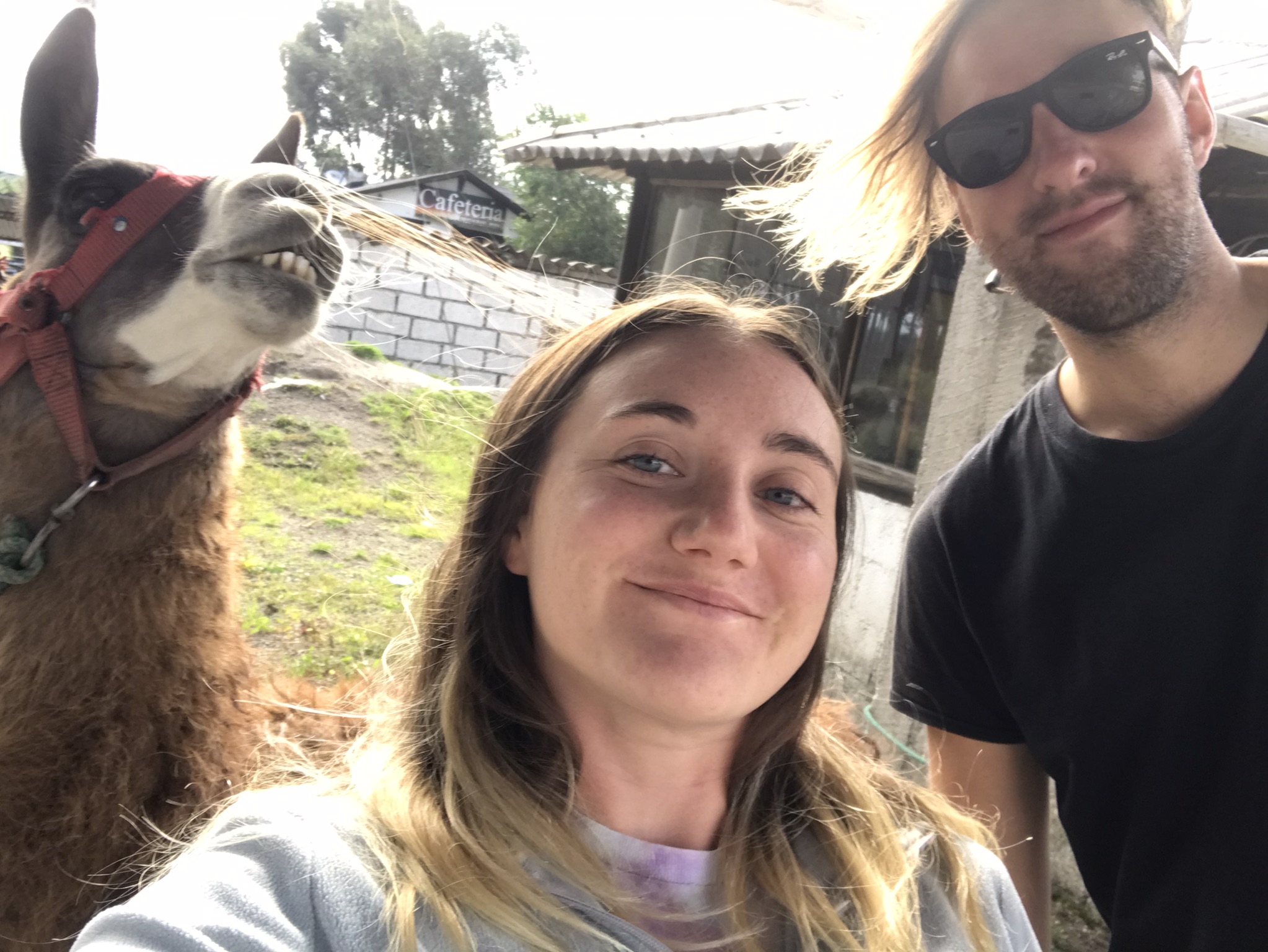After seven months in South America we spent a couple of weeks in the southern part of Brazil at the end of our trip. After just about getting to grips with Spanish in the rest of South America it was a culture shock going to a Portuguese-speaking country, although the languages are similar on paper we really struggled to understand a lot or even do the basics in Portuguese and often had to resort to google translate. Brazil is such a huge country, Brazil travel is a serious undertaking and we were only able to experience a small part of it for now. Our time was mostly spent relaxing, living off coxinhas and caipirinhas and exploring the huge cities of Sao Paulo, Rio de Janeiro and the surrounding areas. To properly explore Brazil would take a very long trip in itself, or most likely multiple trips.
Foz do Iguacu, Curitiba, Sao Paulo, Paraty, Ilha Grande, Rio de Janeiro, Natal
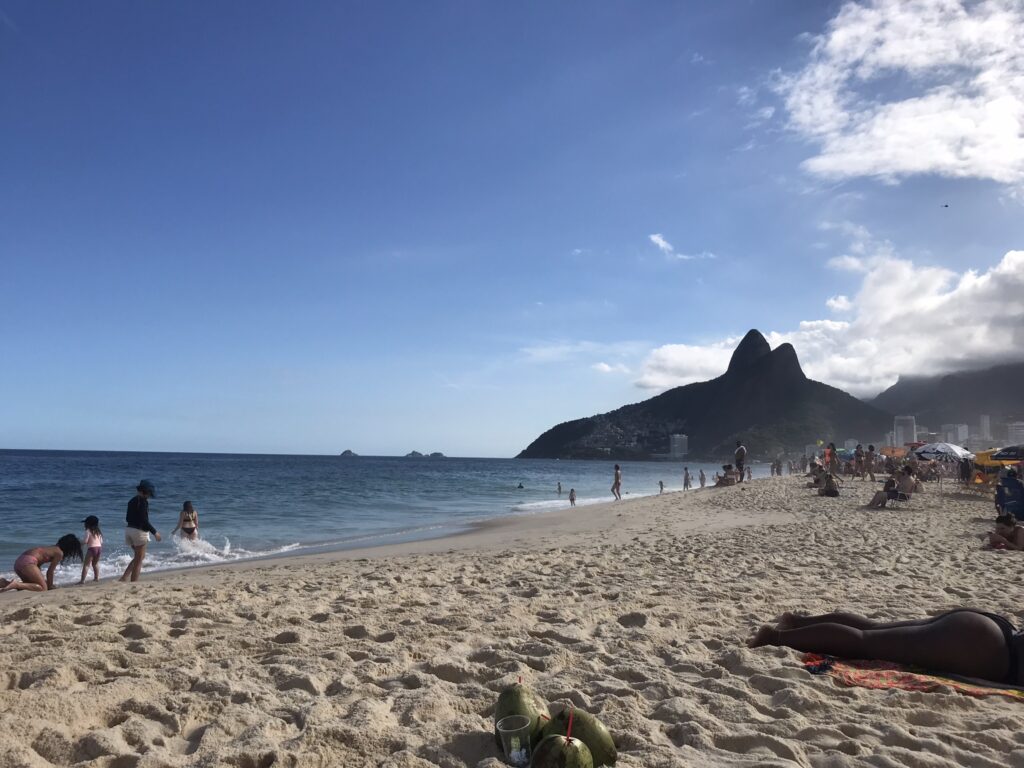
Brazil is a divided and diverse society, especially in the big cities. Those who are privileged and wealthy live in fancy apartment blocks and spend their weekends in places like Paraty and Ilha Grande, and those stuck in a cycle of poverty and potentially crime are banished to the less desirable areas i.e. the slums (favelas) or to the streets. Daily life for residents in the favelas is very different to the wealthy. The government and police essentially leave gangs in charge of enforcing the law (and these are not necessarily the laws of the country but those made by the gang itself), and managing public services. Issues in favelas include overcrowding, structurally unsound buildings built in areas with an increased risk of landslides, unsanitary conditions, increased prevalence of diseases, lack of public services such as rubbish collection, adequate schooling and medical services and social issues such as drug dealing, prostitution and criminal activity.
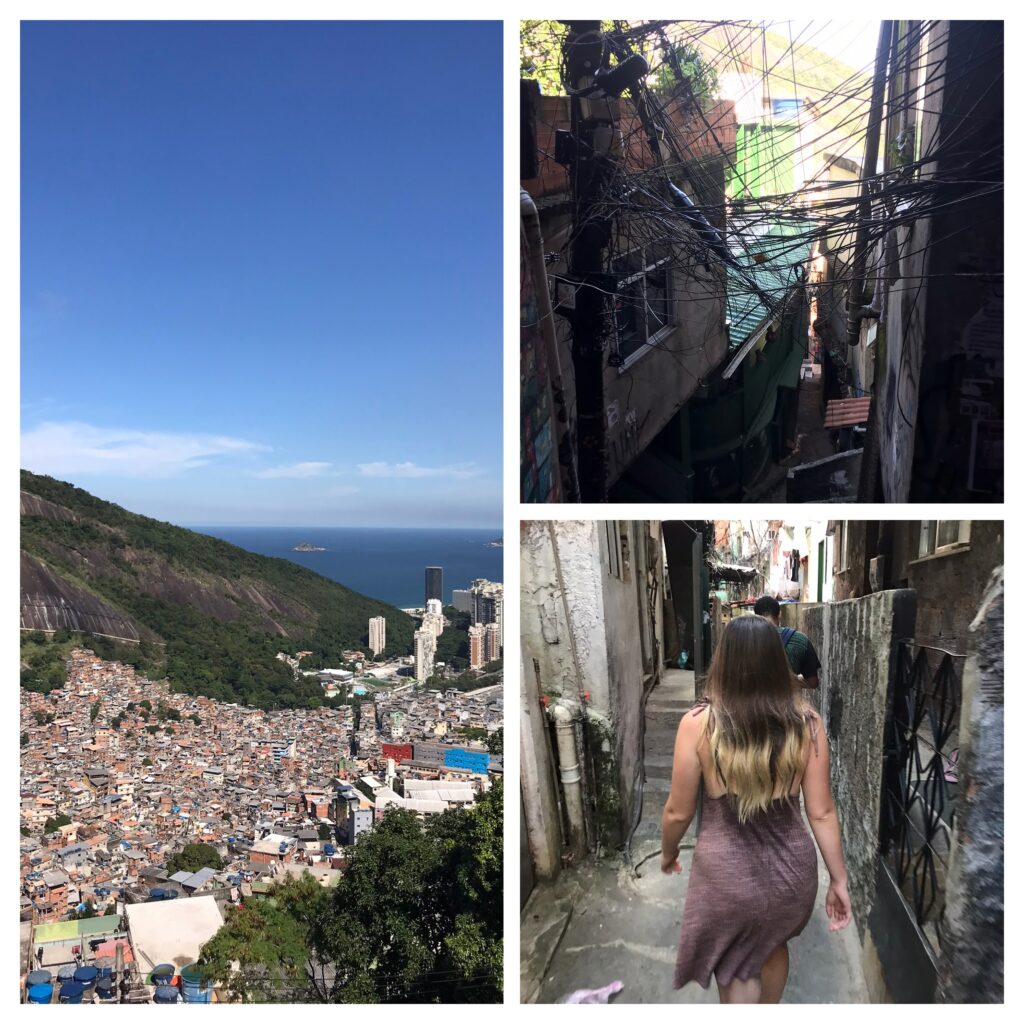
Photos from inside Rocinha favela in Rio de Janeiro
From just walking around the streets in big cities you can get a sense of this wealth inequality. Head to the Cathedral in Sao Paulo and you’ll find hordes of homeless people lining the plaza, to the point where a police riot van is constantly present in the square to monitor any anti-social activity. Poverty is rampant in cities like Sao Paulo and Rio de Janeiro. Homeless people down on their luck sit side-by-side with glitzy high-end shops on Paulista Avenue in Sao Paulo.
Despite this, Brazil is not like the movie City of God. You’re unlikely to stumble into a gun-fight on the street or full on gang warfare. If you keep your wits about you and don’t aimlessly wander around away from the main tourist areas after dark you should be fine.
There are four sacred things for most Brazilians: meat, football, beer and the beach. Football is almost a religion here, in a similar way to Argentina. Brazil also boasts some of the best steakhouses in the world, you may even have visited a Brazilian-style rodizio steakhouse in your country. Alongside this, Brazil claims to have some of the best beaches in the world; everyone knows Copacabana and Ipanema beach due to hits like ‘Ipanema Girl’ covered by Frank Sinatra and ‘Copacabana’ by Barry Manilow, but there are great beaches all over the country. Brazilians take going to the beach seriously, you’ll find them playing bat and ball for hours, decked out with deck chairs, a table and a cooler full of beers. Heading to the beach is the ideal way to spend a weekend for most Brazilians.
The Girl from Ipanema sums up the beach lifestyle well:
‘Tall and tan and young and lovely
The girl from Ipanema goes walking
And when she passes
Each one she passes goes – ah
When she walks, she’s like a samba
That swings so cool and sways so gentle
That when she passes
Each one she passes goes – ooh.’
Brazil is a very diverse country with one of the most diverse societies in the world, with white Brazilians of European heritage, black, mixed-race, indigenous, large Asian and Japanese communities and a strong African influence. Brazil was one of the largest importers of African slaves in the world and still retains this African heritage in its culture, such as samba and carnival.
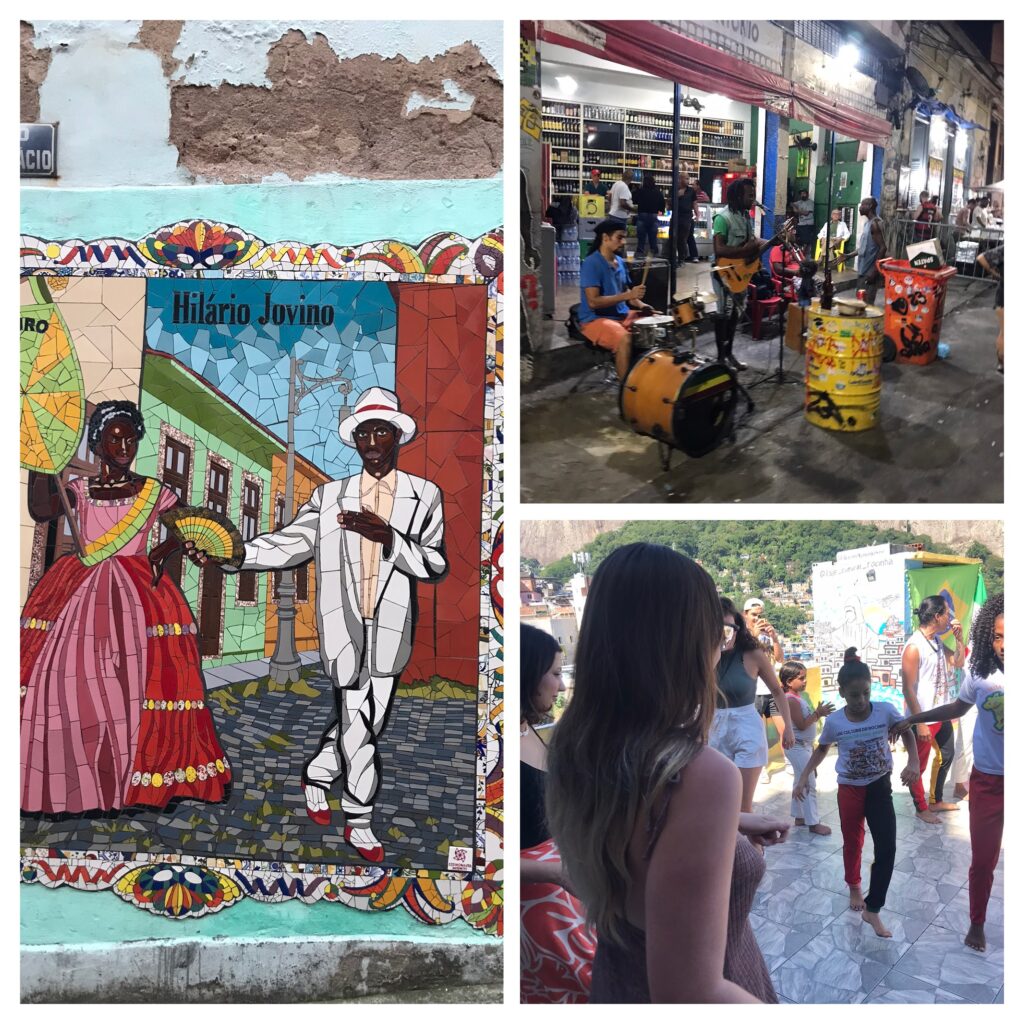
Street art in Pedra do Sal; a local street band performing; getting involved with a local capoeira community project in Rocinha favela.
Safety
Safety is a concern in Brazil, especially in large cities due to the poverty and presence of many petty criminals and gangs. Top tips for leaving with all your possession and self intact and unharmed in Brazil:
- When booking accommodation, research which areas are safe for tourists, especially for Rio and Sao Paulo. You really don’t want to end up staying in a crime-ridden area to save money. It won’t end well. We met some English backpackers who ended up staying next to a brothel in Sao Paulo, not a great look!
- Don’t put yourself in a vulnerable position i.e. by taking drugs or getting ridiculously intoxicated in public places. I would recommend not going out alone after dark, I know this isn’t what solo backpackers want to hear but I would not have felt safe on my own walking around in Sao Paulo, Curitiba or Rio de Janeiro. It’s the not-so-nice truth.
- Take an Uber if you want to go to a restaurant or bar in another area of the city if it’s after dark. Uber is everywhere in Brazil and is inexpensive, and it’s better to be safe than sorry!
- Don’t get lost in an area you’re unfamiliar with, you might accidentally walk into a dodgy neighbourhood and could be targeted by impulsive criminals.
- Always download the offline map of the city on google maps (or whatever app you use). This is a great backup if you get lost; it got us out of so many sticky situations.
- As a rule of thumb in the big cities like Rio de Janeiro, São Paulo and Curitiba, be extra cautious when venturing out after dark. Only carry what cash you need and avoid bringing your passport. Stay close to your accommodation – we only ventured a block or two away from where we were staying after dark in these cities.
- Order a takeaway if you’re worried about going out after dark – there are delivery apps available to download.
- Don’t go down any dark alleyways or areas that are deserted, stick to areas which are well-lit, ideally with people around. Be careful in crowds too as these provide ideal cover for bag/phone/camera snatchers wanting to blend in.
- As major tourist hotspots, we found Ilha Grande and Paraty to be much safer in comparison with the bigger cities and felt more comfortable to venture out at night.
Foz do Iguaçu
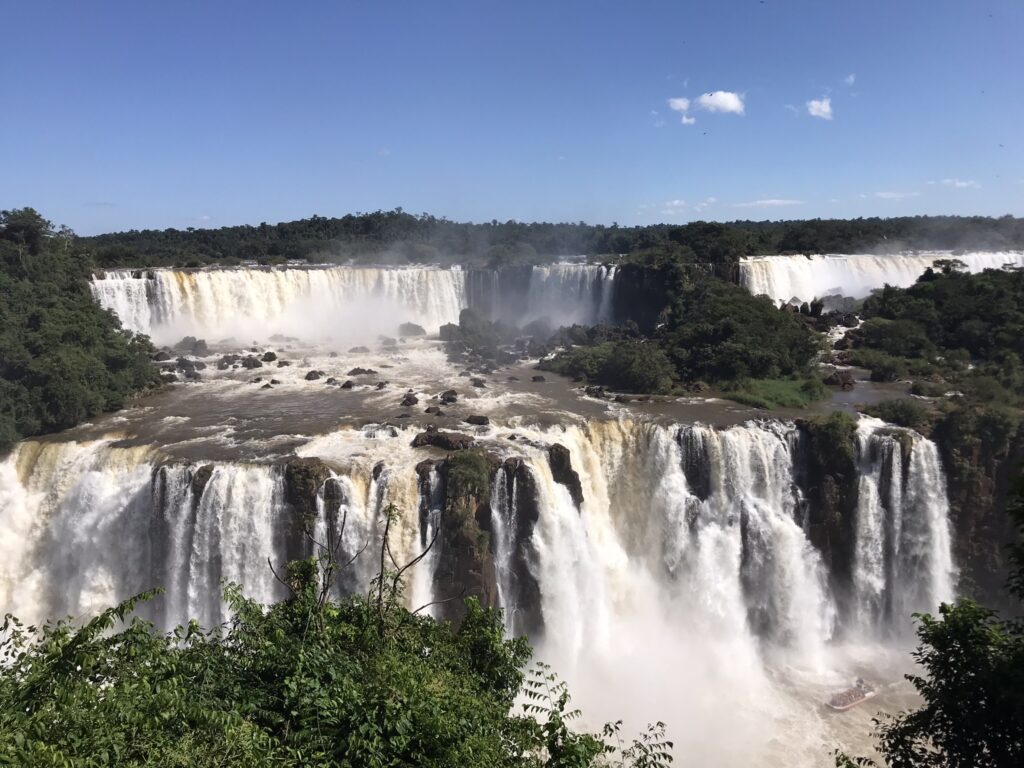
A good base if you’re visiting Iguazu falls from the Brazilian side. Foz do Iguacu is a much bigger city than Puerto Iguazu on the Argentinian side, it felt like a real city rather than a small town. If you are heading to or from Paraguay as we did I would advise against traveling by bus across the bridge from Ciudad del Este, it’s much quicker to just walk across the border due to unrelenting traffic jams on the bridge.
Accommodation
Airbnb close to Terminal de Transporte Urbano Pedro Antonio de Nadai
Foodie Places
Churrascaria Premium – an archetypal Brazilian buffet, all-you-can-eat salad buffet accompanied by an endless supply of meat including various cuts of steak, grilled pineapple, garlic bread and halloumi. I recommend pacing yourself when it comes to the buffet and saving your appetite for the meat. This buffet was a little on the expensive side however we LOVED the meat!
Super Muffato Foz do Iguaçu – Portinari – even supermarkets have a kilo buffet, the quality isn’t fantastic and I can’t promise that it’s hygienic but it is cheap food.
Activities
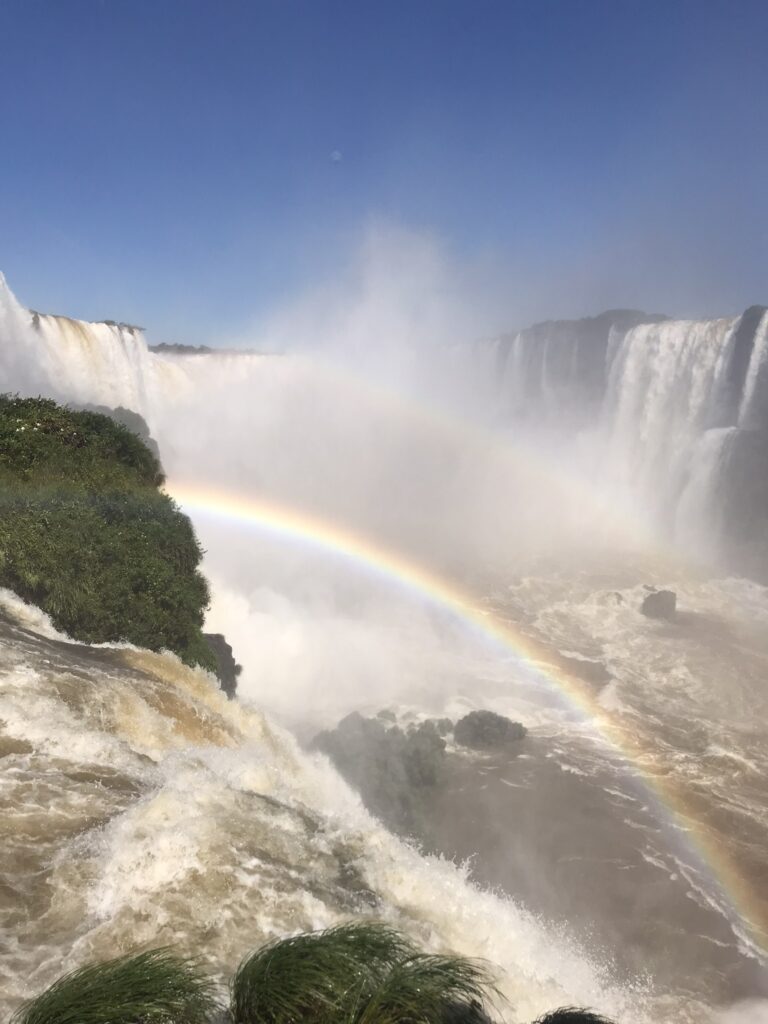
Visit the Brazilian side of the waterfall – head to the Urbano bus terminal and jump on the bus to the waterfall, be aware that the bus gets really full so I advise leaving earlier rather than later or endure being packed into the bus like we did. Once you arrive at the park, you need to buy your ticket, you’ll also be given a specific bus time to catch the bus into the park itself. The trail doesn’t take much time to complete, we finished the whole route in about an hour and we stopped incessantly to take photos. Controversial opinion but I preferred the Brazilian side of the waterfall to the Argentinian side totally based on the fact that the crowds annoyed me at the Devil’s throat section of the Argentinian falls, however the Argentinian side had more hiking trails and things to do than the Brazilian side. I felt that the Argentinian side was almost like a theme park with a mini train and food options. I highly recommend bringing an umbrella and rain poncho if visiting either side, but especially the Brazilian side as there is a section that you will get absolutely drenched on, it’s optional to walk along the path closer to the waterfall and you don’t have to get wet but if you do choose to go this way then the spray is pretty heavy, it’s all part of the fun though.
Curitiba
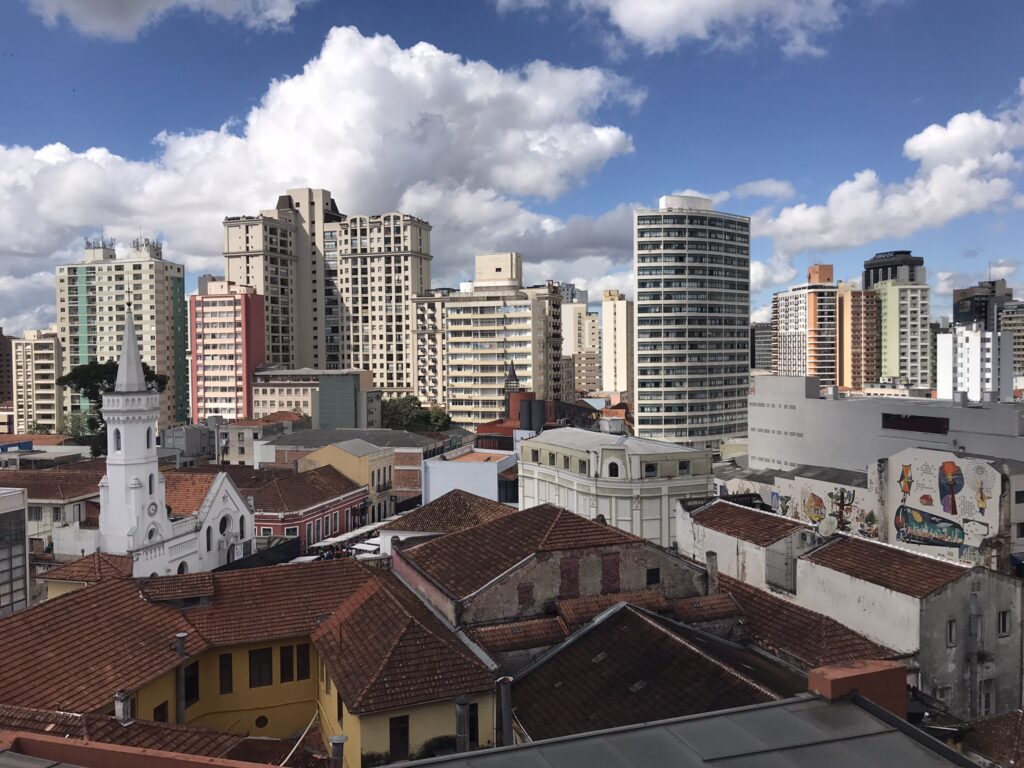
We decided to break up our journey to Sao Paulo and spend a few days exploring Curitiba. This is a student city with a youthful vibe, however there were still some dodgy/homeless people around the city centre especially outside the main Cathedral, and we were told by a concerned local elderly lady to watch out with our phones when taking pictures in one of the main squares! Generally though Curitiba mostly felt safe enough to walk around and had quite a lot to do.
Accommodation
An Airbnb again – we found it was much cheaper to stay in Airbnbs than hostels in Brazil, this took us by surprise as often it was cheaper to get an Airbnb than stay in a shared dorm room!
Foodie Places
We didn’t actually eat out here, we were penny-pinching towards the end of our trip so cooked some pasta in the Airbnb.
Activities
Self-guided walking tour of the city centre. It was difficult to find any info online but Dan was able to get a route and some info together from various sources to create our own tour, you can find the tour here!
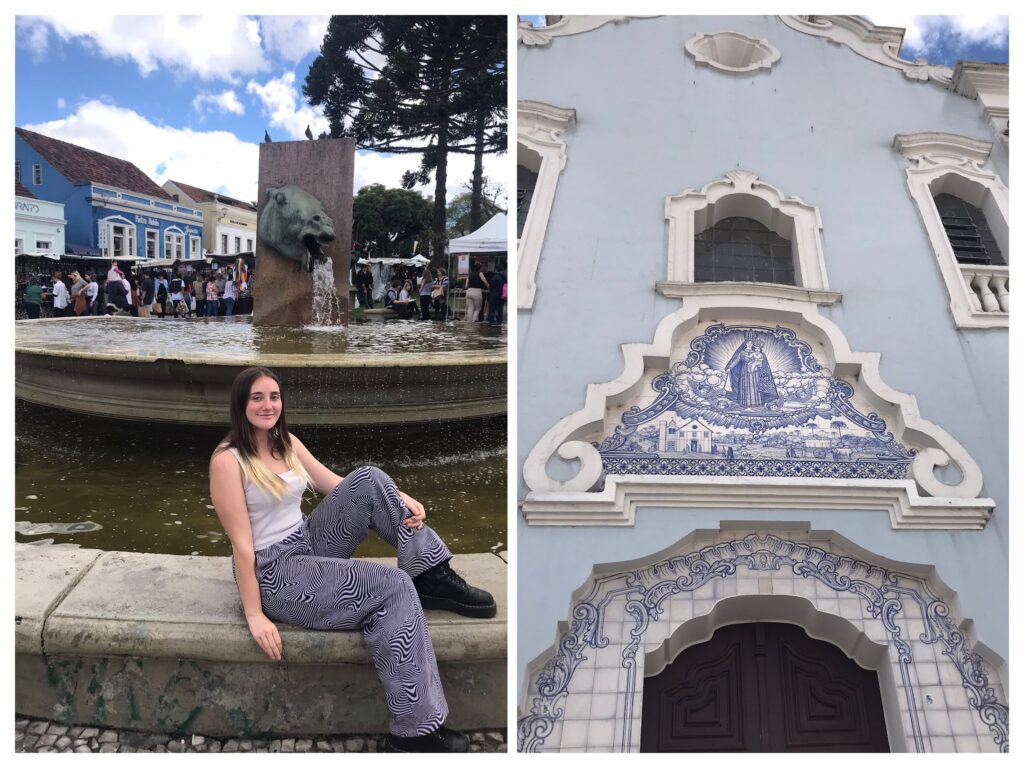
Dan’s magical mystery tour of Curitiba
Memorial de Curitiba – we stumbled into here whilst wandering around the city, this exhibition space is free to enter and there are galleries to look around and some info about the history of Curitiba state. The information boards here are not in English so bring google translate or a Portuguese speaker
Passeio Público – again we found this place by chance whilst walking to the Oscar Niemeyer gallery, there are many exotic birds in an aviary, well worth a look if you’re taking the same route we did.
Museu Oscar Niemeyer – very interesting modern art gallery, we particularly loved the African tribal sculptures. There was a variety of different exhibitions here, some of them were quite disturbing, especially a temporary exhibition of garish-looking dolls and an exhibition in the next room which featured footage of what looked like a strange pagan-style ceremony in the woods!
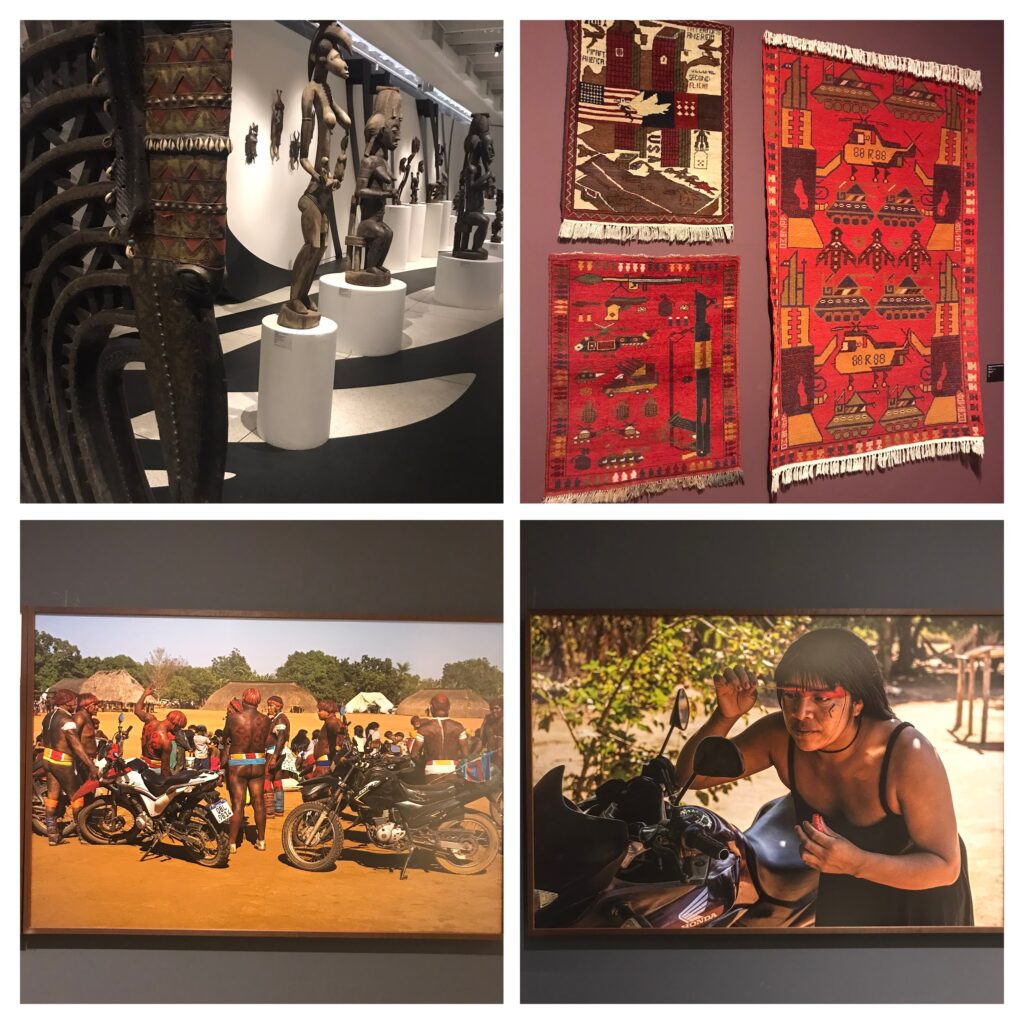
Some of the exhibits in the Oscar Niemeyer museum
Sao Paulo
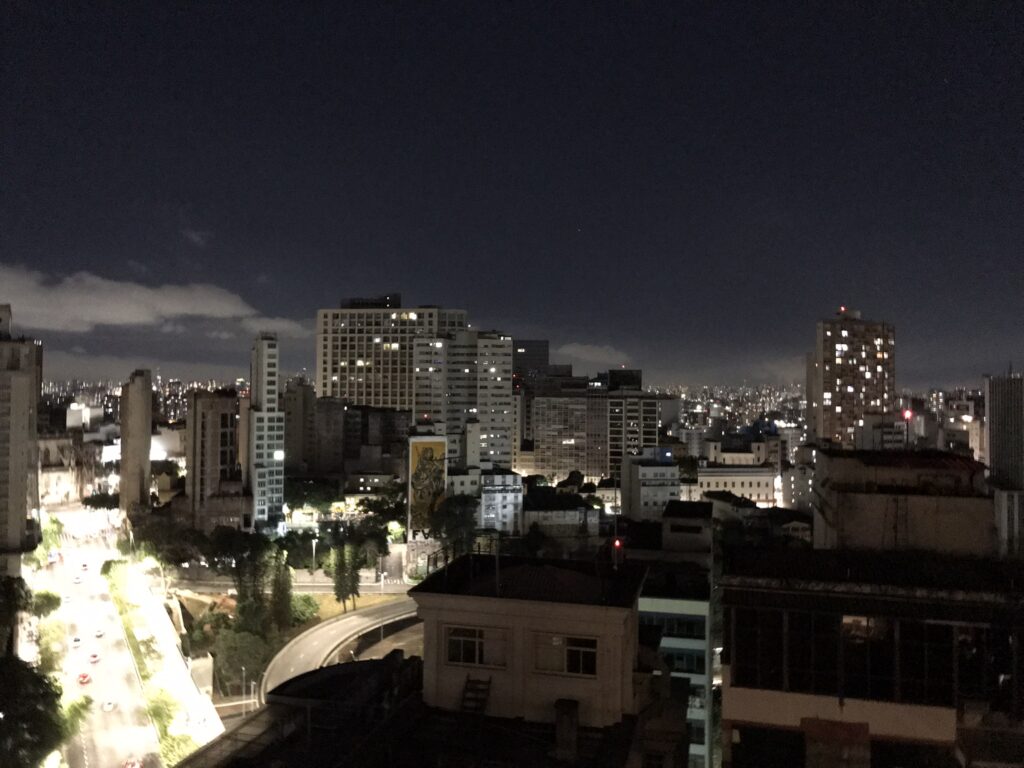
Sao Paulo is one of the only places on our South America trip that I would not go back to. I was immediately struck by the social issues within the metropolis. It’s obvious to any visitor that there is a serious homelessness and substance abuse epidemic, most visible on the streets. This was most clear to see when visiting the Cathedral (Catedral da Sé de São Paulo), crowds of homeless numbering at least 50 lay sprawled on the ground in groups in front of the grand façade of the church, there was a constant police presence with 3 riot vans in the square. The plaza felt unsafe and we tried to avoid passing through it again.
Accommodation
Airbnb near Bela Vista – I put a lot of time into researching where to stay in Sao Paulo as I’d heard there were some neighbourhoods to stay away from. I opted for Bela Vista with the closest metro station being Japão – Liberdade. You can get a metro directly from the bus terminal to Japão – Liberdade, which is very useful especially since we struggled to even find the exit at the bus terminal to begin with. We really enjoyed staying close to Japan-town as it meant authentic Japanese sushi, bingo! It is worth mentioning that the streets did feel quite sketchy here, there are a LOT of homeless people hanging around and I wouldn’t have felt comfortable walking around alone at night. We mostly ordered takeaways to avoid leaving the apartment at night.
Foodie Places
Paulista Hot Dog – if you like weird combinations of ingredients with hot dogs, this is the place for you. You can find hot dogs topped with mashed potato, sauerkraut and other unorthodox additions at this fast food joint. I was told about Sao Paulo hot dogs by Barbara, a Paulist who we’d met on the Uyuni Salt Flat tour, and it was a great recommendation.

Mortadella and sushi in Sao Paulo
Restaurante Bentô House – in the heart of Japan-town, gyozas to die for!
Mercado Municipal de São Paulo – there’s a nice seating area with various restaurants to choose from upstairs, you get the best view over the market from there, we tried the iconic Mortadella sandwich here, the sandwich is so big that two people can easily share one for lunch, alongside a beer of course!
Activities
Paulista Avenue – bustling avenue which is the heart of the city and contains many notable buildings.
Parque Ibirapuera – a tranquil park just outside the city centre which can easily be accessed by bus.
Self-guided walking tour of central Sao Paulo with GPSmycity, visiting the Cathedral and Municipal Market

Japan-town – Sao Paulo is home to the biggest Japanese community outside of Japan and Japan-town is a hub of Japanese culture, we found it really interesting to see the Brazilian-Japanese food stalls and the many homages and Japanese references and shops around the area.
Paraty
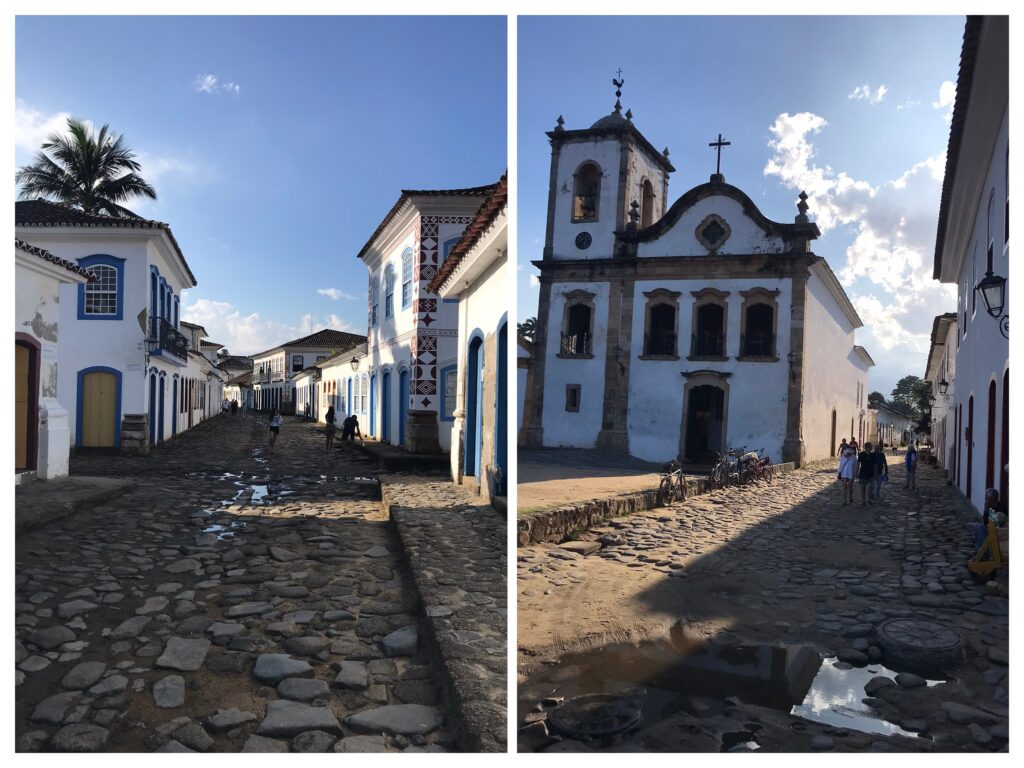
The cobbled streets in Paraty are designed to periodically flood and clean themselves
Cobblestone roads. Colonial churches. The home of the descendant of the Emperor of Brazil. Paraty is a popular tourist destination for Brazilians and international visitors alike so is a little more expensive than other parts of the country. The town itself is picturesque and has a lot of interesting colonial history which has made it a UNESCO World Heritage Site, while it is also a good base to visit the nearby Atlantic forests or the paradise islands and beaches in Carioca Bay. It is also one of the spiritual homes of cachaça, we loved the local ‘Gabriela’ liqueur and the special Jorge Amado cocktail.
Accommodation
Airbnb in the old historical district, close to the pier. You will need to walk from the bus station if staying in the old town as most of the roads are not suitable for vehicles.
Foodie Places
Restaurante Vinicius Paraty – this was a very classy, suave dining experience, we really enjoyed the quality of the meal, especially the caipirinha!
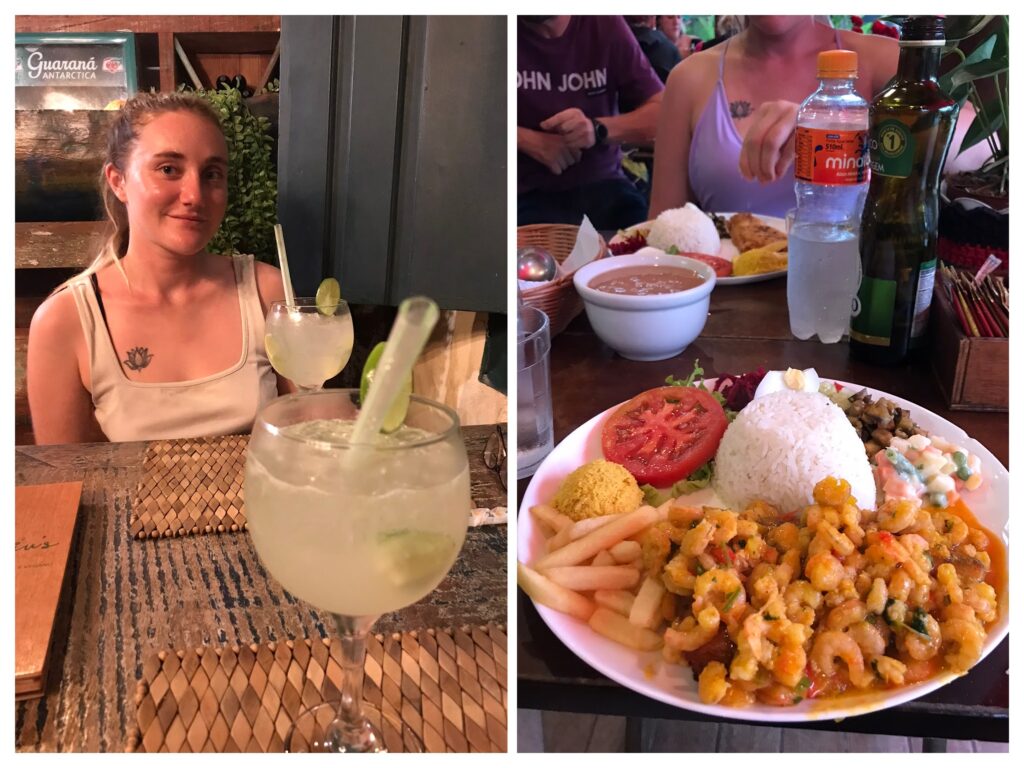
Caipirinhas at Vinicius and lunch at Do Neguinho
Do Neguinho Esfiharia & Boteko in Trindad – try to move past the mildly racist slur in the name, it’s one of the cheapest places to eat in Trinidad and the portions are huge.
Activities
Free walking tour around Paraty booked through Guruwalk
4×4 Atlantic jungle tour including a visit to a Cachaça distillery (who doesn’t love a free tasting!) and Cachoeira Do Toboga – this is a natural waterslide, be very careful when climbing to the top as it’s very slippery and dangerous, just before we arrived someone was taken away in an ambulance! If you’re unsteady or unsure, just don’t take the risk. I did and loved it but I was with a guide who was able to advise me how to go down the rock. We were told that there’s usually a man who helps tourists surf whilst going down but we didn’t see him.
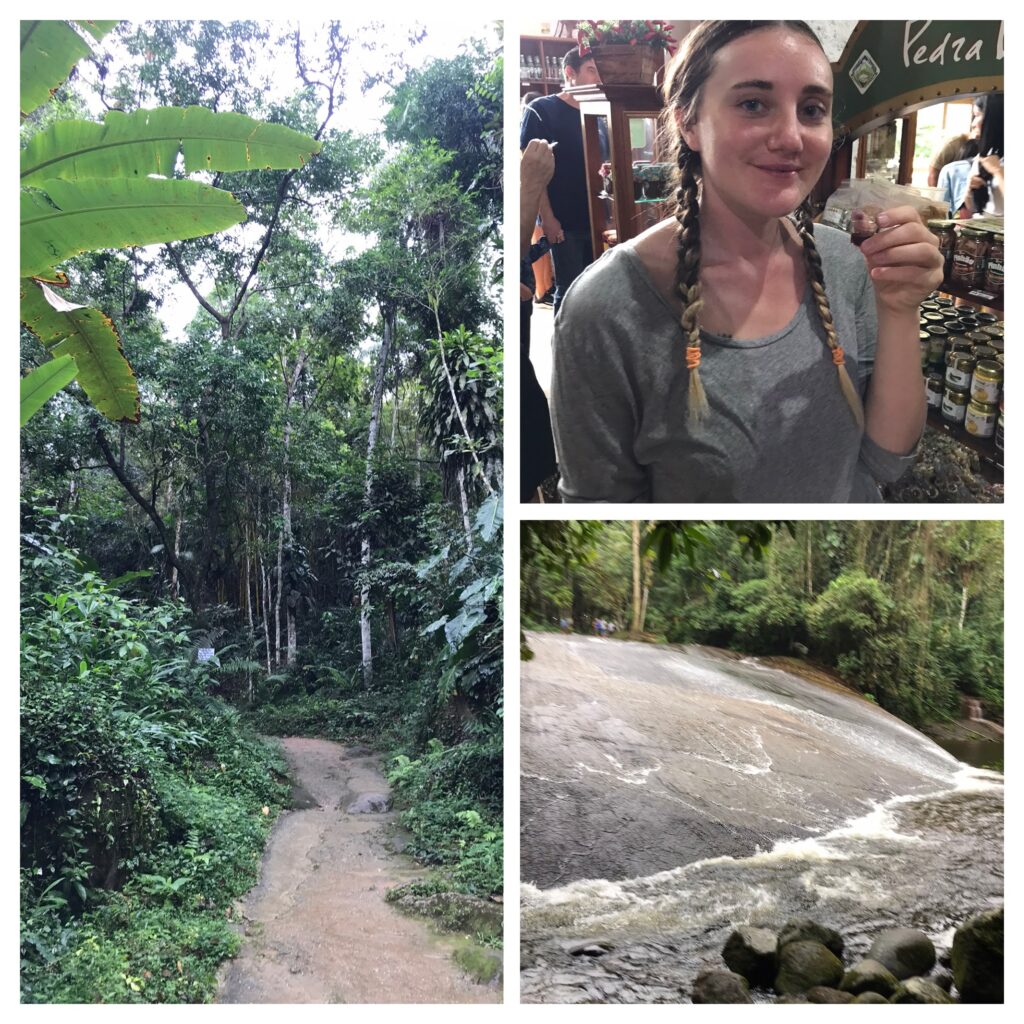
Jungle scenes near Paraty
Águas Claras Boat trip (both tours with Paraty Tours), snorkelling equipment, floats and paddle-boards are provided. We felt this boat trip was aimed at Brazilians on holiday. The price of drinks and food was inflated so we nibbled on sandwiches that I’d pre-made. We did treat ourselves to a caipirinha! Half of the boat trip is spent traveling and the other half is spent bobbing in the sea.
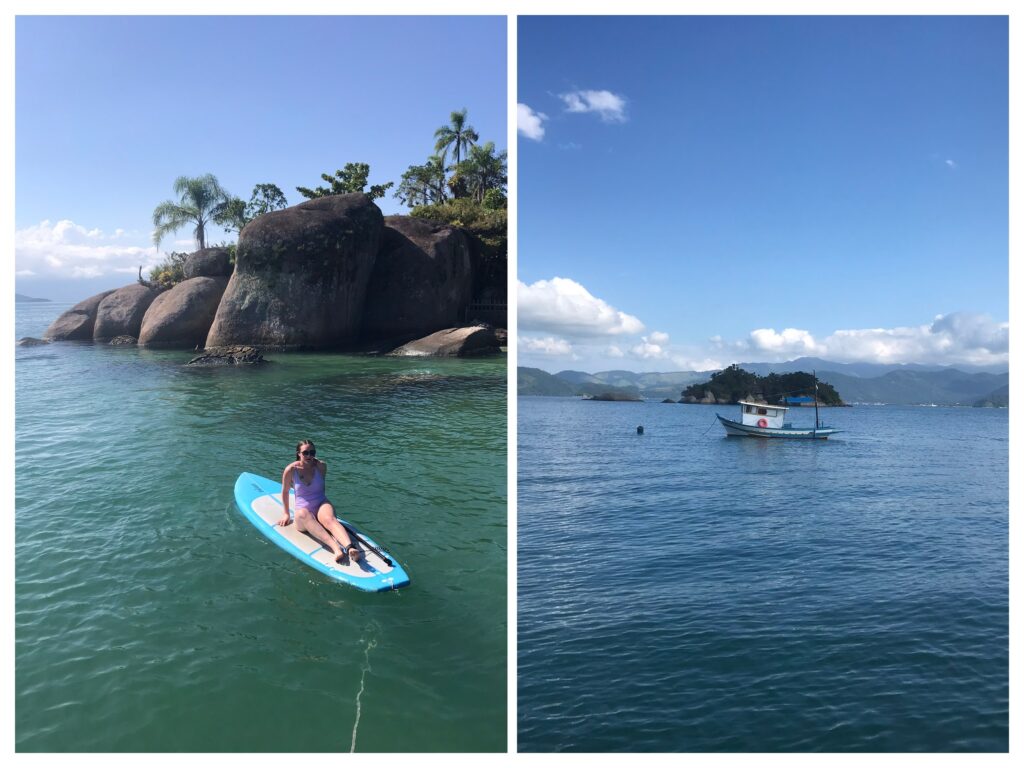
Day trip to Trindad, a little fishing village which is now a tourist hotspot due to its laid-back vibe and beaches. We caught the bus here from Paraty bus station. We struggled to find accurate bus times as we visited on a national holiday so we had to wait around a while and ask the ticket office what time the bus was going, however the regular bus timings are posted on the ticket office window so it would usually be straightforward. Despite regular buses, the road to Trinidad is not designed for a bus so find a handhold and don’t let go, it’s a white-knuckle ride to get to the village. There is one quirk to point out about Brazilian beaches, there are hawkers on the beach that will offer you deck chairs, a table and parasol, these are not free, you have to pay to use them. Make sure you agree on a price before you sit down as it’s better to know beforehand if they plan on ripping you off. These hawkers will also offer to get you drinks and food, be aware that the price will be inflated. Brazilians, from my observations, usually use this beach service however you are not obliged to do this, just say no thank you and find a space for your towel on the beach. Trinidad has a couple of beaches to explore and a main sandy street with some hostels and fish restaurants. When it came time to get the bus back to Paraty there were a lot of Brazilian beachgoers hanging around who had spent the day relaxing and drinking on the beach and were starting to dance and sing in groups, it looked like they were setting up for a pretty wild party.
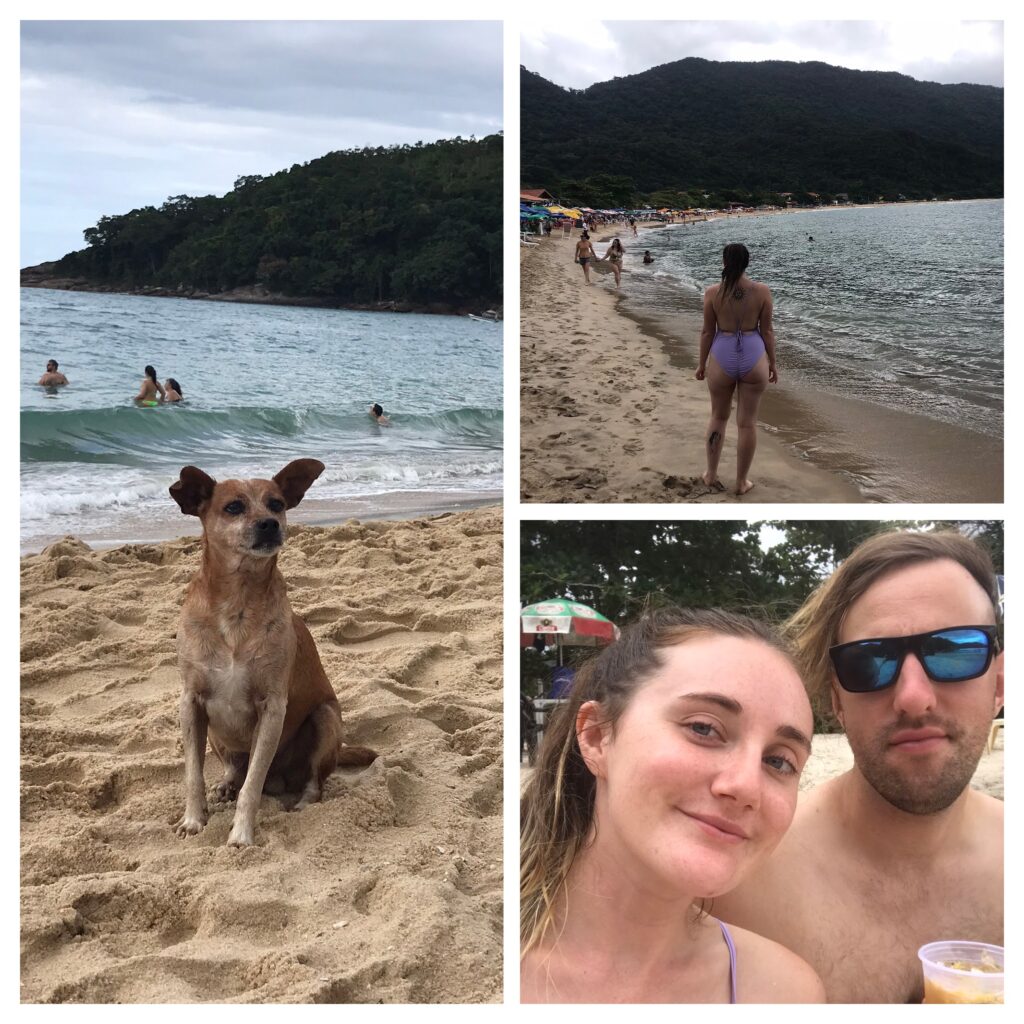
Enjoying the beach at Trinidad
Ilha Grande
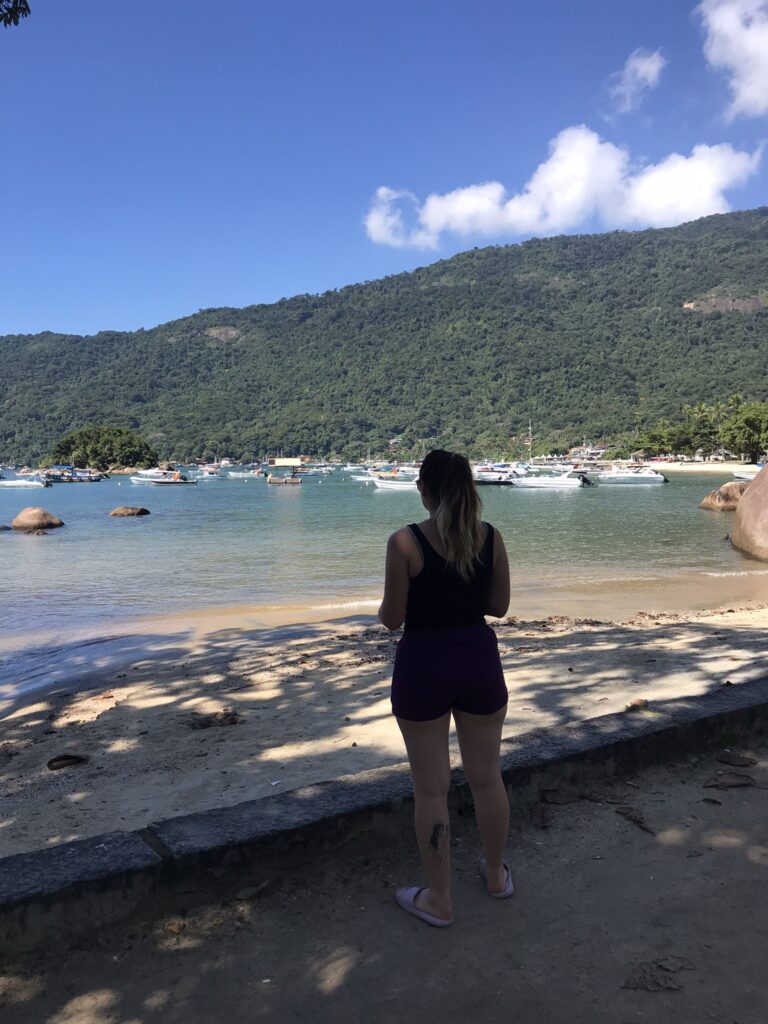
An island paradise not too far from Rio de Janeiro. There are no cars on Ilha Grande and police get around on quad bikes, while local guys make a service of carrying goods, supplies or tourists’ luggage in large wheelbarrows. Ilha Grande is sparsely populated, the main settlement is Abraao which is where the ferry arrives from the mainland, most other parts of Ilha Grande are more difficult to reach with many isolated beaches and guesthouses usually only accessed by private speedboats. Ilha Grande was the place where we had the best caipirinha of our whole time in Brazil, very limey. The price of food in restaurants was a little expensive here, however there were a couple of supermarkets in Abraao that stocked most basics and essential items.
Getting to Ilha Grande means taking a boat from the mainland. There are three main departure points for boats from the mainland to Ilha Grande: from the towns of Angra dos Reis, Conceição de Jacareí and Mangaratiba, and all of the ferries go to Abraao on Ilha Grande. Where you are coming from will probably determine which port you use. As we were coming from Paraty we got the bus to Angra dos Reis, and from there took the ferry to Abraao. There are two options when it comes to ferry travel from Angra to Abraao, you can get the more expensive and faster speed boat from the main pier or you can get the slower cargo ship, this boat only goes about twice a day but it’s much cheaper than speed boat. The slow ferry leaves from Terminal CCR Barcas in Angra dos Reis. We had trouble finding the departure point for the ferry, it looks almost like a derelict stretch of pier and if you arrive too early there might not be anyone around, but if you walk right to the end of the pier then you will see the waiting area and ticket booth for the boat.
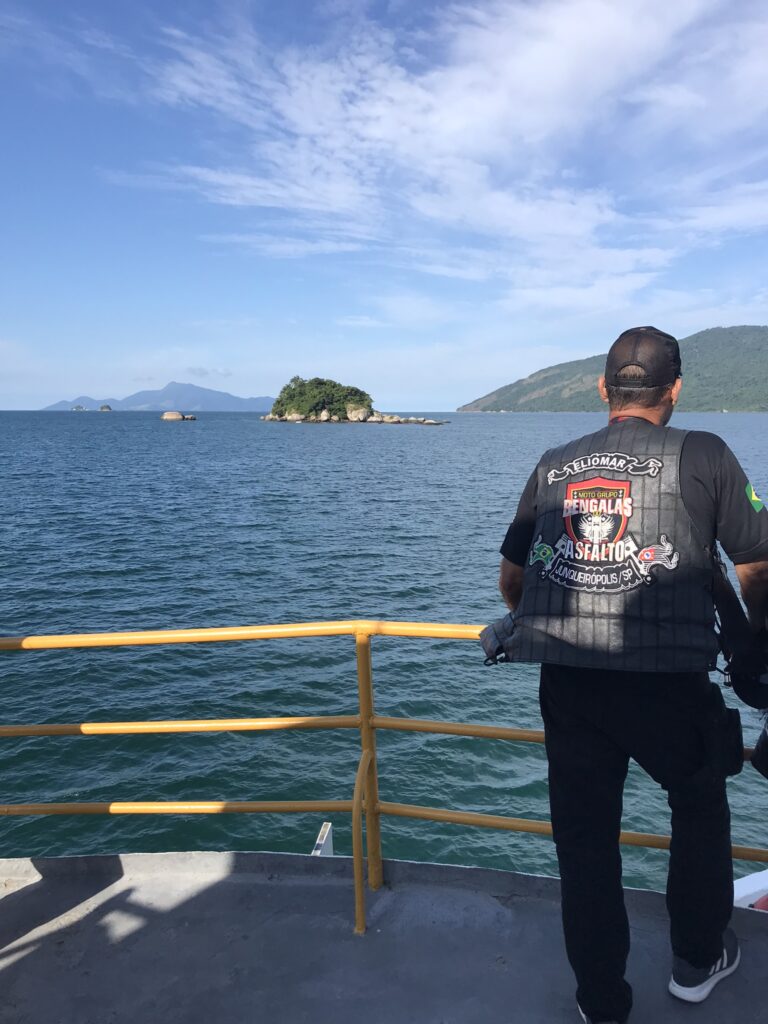
On the way to Ilha Grande
When returning from Ilha Grande to the mainland it’s possible to book your return crossing and bus tickets to Rio de Janeiro from the ticket office at the pier in Abraao, so don’t stress about organizing everything before you arrive. We booked a combo boat-bus ticket to Rio which meant first getting a boat to Conceição de Jacareí and then catching the bus from there. There was a little confusion at the pier in Abraao when boarding the boat as we needed to wait for the correct boat to arrive, several boats full of people came and went and for some reason we ended up on a boat with just ourselves and the crew. In the small town of Conceição de Jacareí we picked up some snacks and waited at the harbour area for a while before heading to the bus stop. There was no ticket office and just a concrete bus shelter next to the main road so we weren’t sure if we were in the right place, the bus didn’t come at the scheduled time and after waiting for about 30 minutes longer we eventually decided to maybe ask at a local shop to check if we were in the right place, just at this moment our bus came speeding around the corner, we flagged it down and were able to get to Rio without any problems.
Accommodation
Coco Suites – highly recommend, the owner is fluent in three languages and very helpful, there’s also a fully stocked kitchen should you want to save money and cook your own meals. On the downside it is quite a steep walk up the hill from the centre of Abraao.
Foodie Places
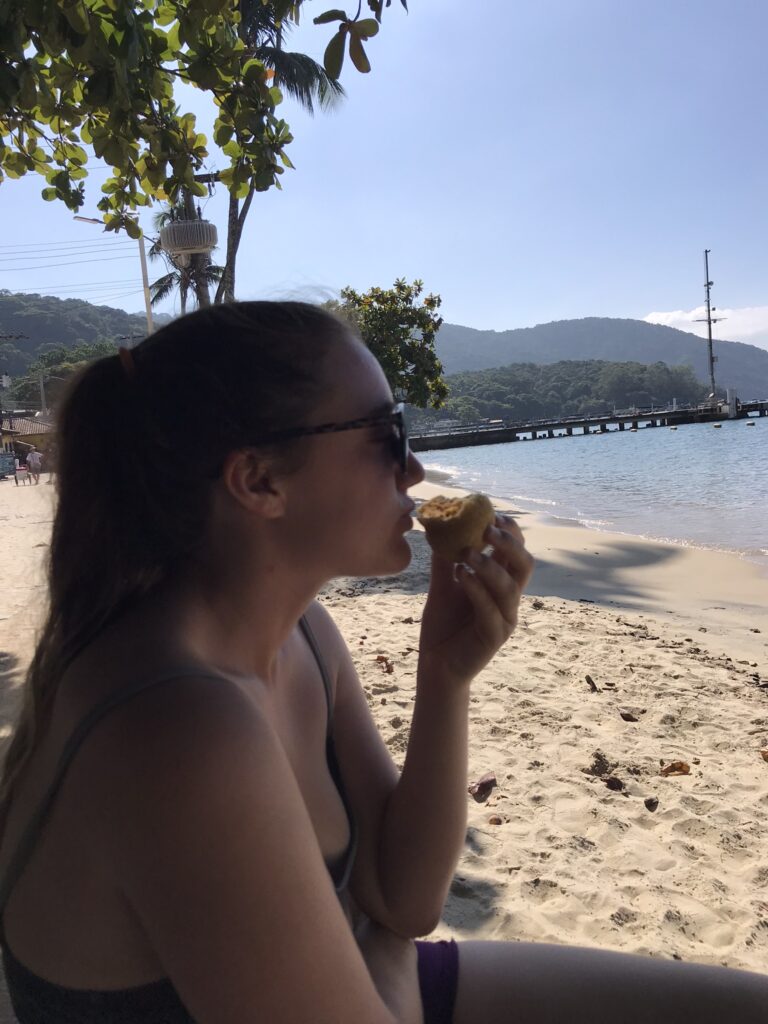
A coxinha on the beach, what could be better
Restaurant God is Good – restaurants tend to be on the expensive side here so we opted to share the Moqueca which is a Brazilian fish stew and weren’t disappointed, we returned back to this place again for the Moqueca and cheap caipirinha offers!
For lunch most days we got coxinhas from a kiosk which I think was on Rue Alice Kuri, this was a local street-food place which was not on any maps. The old lady who ran this place was a real character, she undercharged us as she didn’t have any change so we gave her a Paraguayan coin that we were carrying which made her very happy.
Activities
We made our way towards Praia de Abrãaozinho as we’d been told this was the nicest beach close to the town centre. The trail is quite challenging with lots of tree roots and a section where you need to wade through the sea, which isn’t a great idea at high tide. I would recommend bringing trainers or walking boots as I kept losing my flip flops and Dan was in a lot of pain barefoot. We only made it to Crena beach in the end as we gave up!
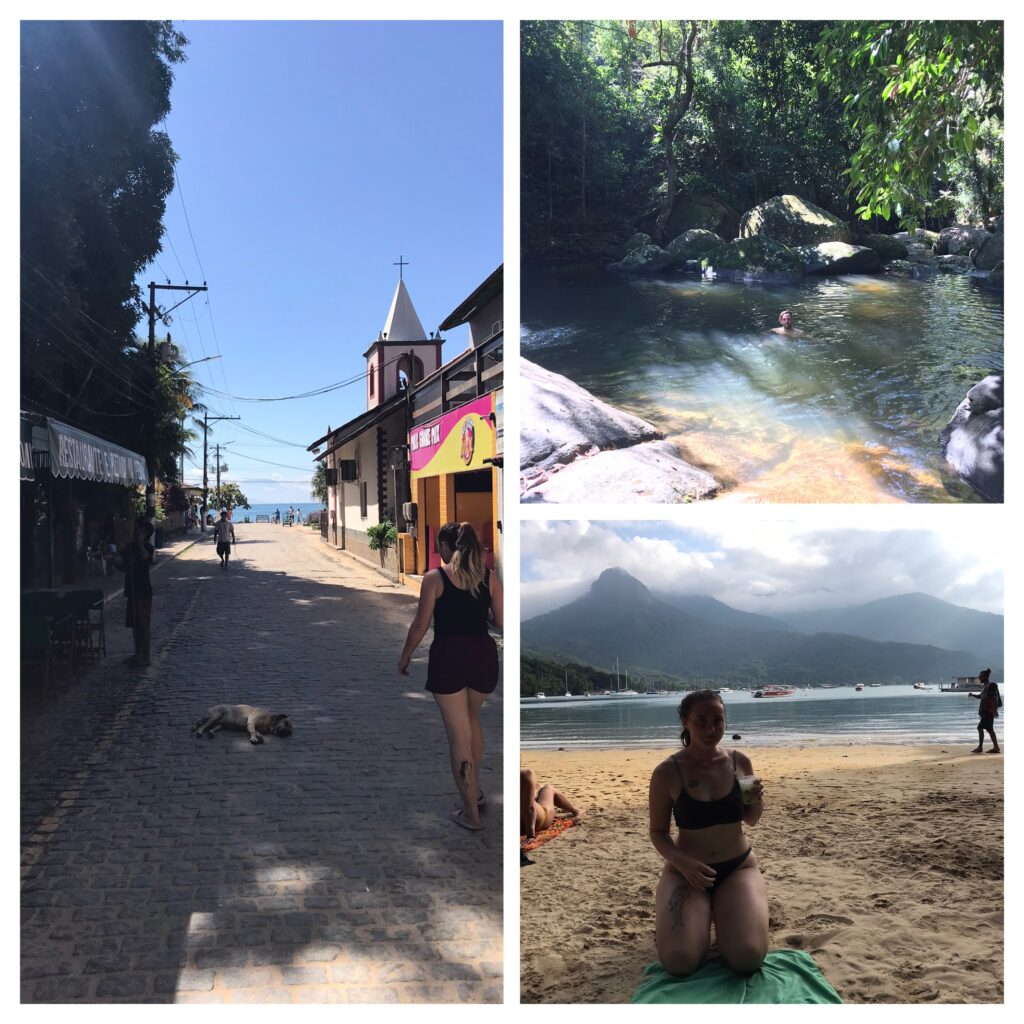
Natural pool near the fort, a caipirinha at Crena beach & street views in Abraao
To the north of Abraao are the ruins of the fort which was used to quarantine immigrants arriving to Brazil, immigrants arriving on boats would have to quarantine on Ilha Grande before they were allowed to land in Brazil, this was to prevent the spread of disease from mainland Europe to Brazil. The fort is just a ruin now and has mostly been reclaimed by nature but is still interesting to see, you can walk here from Abraao and there is a short walking circuit which also includes an aqueduct and very nice fresh water natural pool to take a dip in.
Day trip to Lopes Mendes beach – first head to the beach in Abraao near O Pescador, there will be touts selling tickets for boats to Pouso beach. The prices are the same across all boats and different touts so there is not much point trying to haggle. Make sure you book a return ticket as well as it’s difficult to arrange this at Pouso beach and you’ll probably have to pay an exorbitant amount if you don’t book in advance as boats are usually scheduled for specific numbers of people. I also recommend bringing food and drink with you as there are no restaurants at Lopes Mendes, the closest is at Pouso beach. Pouso beach is the closest drop off point for Lopes Mendes, you then need to follow the marked trail which takes about 20 minutes through the jungle terrain, we saw monkeys along this stretch. Make sure you leave enough time to walk back before your return boat. We found that the waves were very strong at Lopes Mendes. I’m not sure if this is normal or not but keep an eye on kids or smaller people as they may get bowled over in the current.
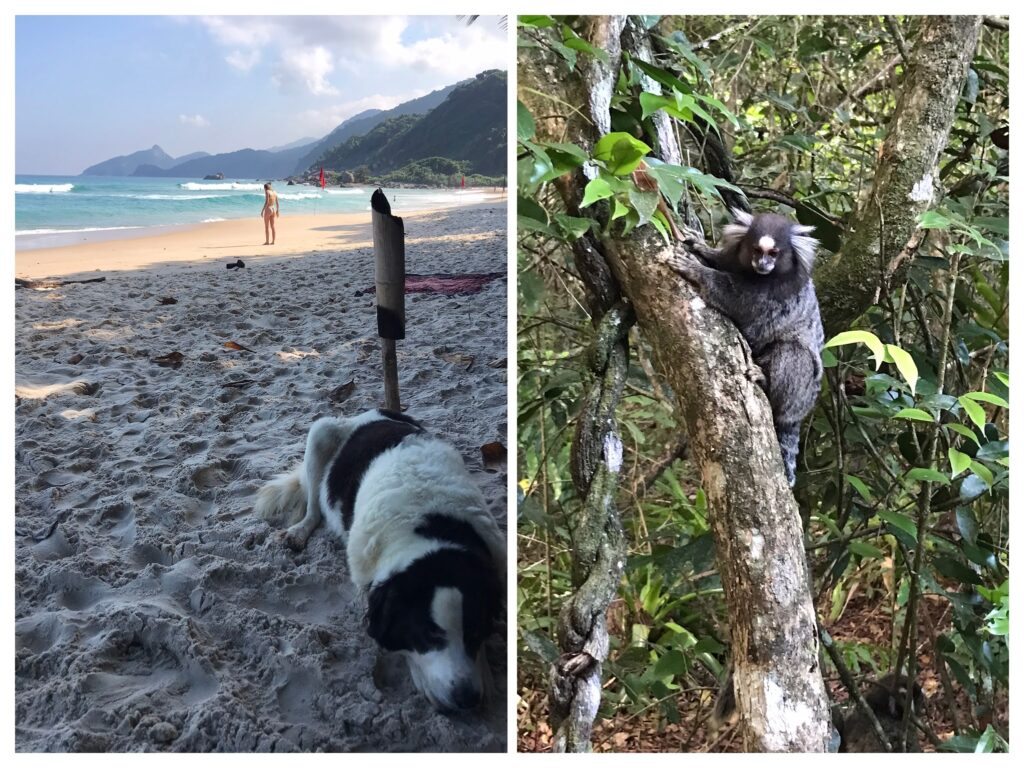
Rio de Janeiro
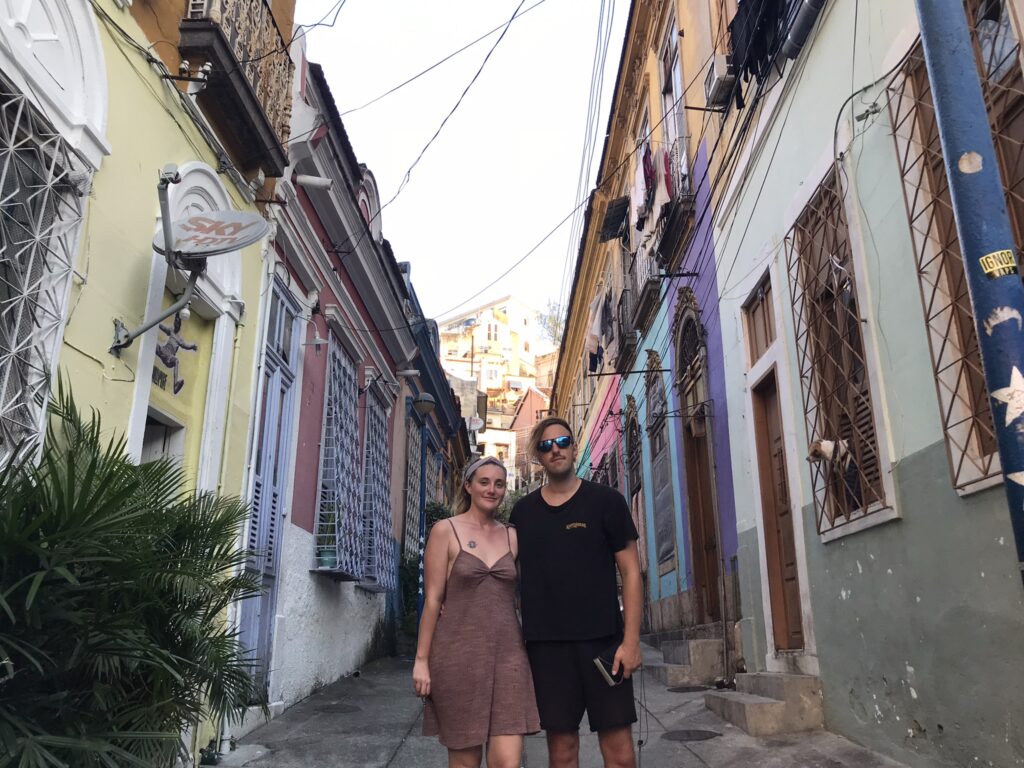
A thriving metropolis that also manages to retain a unique local character and community spirit. Unlike a lot of big cities which become bland concrete jungles, in Rio you can still dance samba with the locals at Pedra do Sal or lap up the sun with the local beach bums and admire the bat-and-ball skills at Ipanema and Copacabana. Rio’s reputation is deserved, it has many distinct neighbourhoods each with a life and culture all of its own. The metro is very easy to navigate so it’s easy to get around the city and enjoy the wide variety of experiences that Rio has to offer.
Accommodation
Airbnb in Lapa – we wanted to be close to the city centre but also be able to dip our toe into the thriving nightlife scene nearby.
Foodie Places
Gohan Alimentação Natural – we liked the sushi here.
Hoje tem Curry! – Comida Indiana – the curry is served with accompaniments here which we really liked, overall excellent meal.
Restaurante Lá na Criação Lapa – the best and cheapest kilo buffet we visited in Brazil, loads of vegan options available too.
Calabrezza Pizzaria – nice pizzeria in the Lapa district.
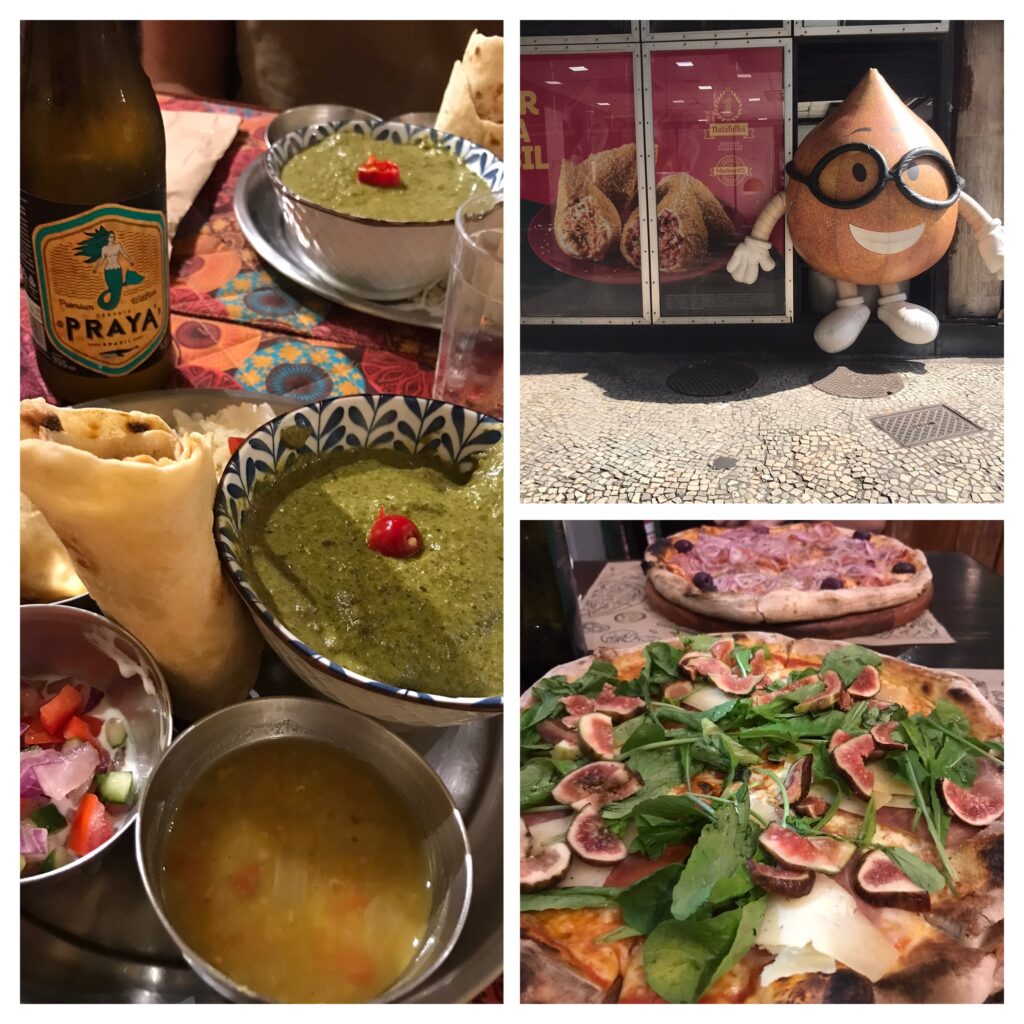
Ponto de Encontro Ximeninho – when it gets dark this intersection comes to life with tables on the sidewalk and Cariocas drinking cocktails and beer, eating steaks and chatting with friends. It’s a very social place to come if you want to eat and drink late into the night.
Activities
Christ the Redeemer – expect it to be overcrowded with tourists all trying to get the best photos here, we had fun watching people trying to barge through the tourist hordes and inadvertently photobombing each other. If you have the option, try not to go on a cloudy day as the view from the top won’t be very good. On the day we visited we were warned by locals that it was too cloudy and to come back another day, we decided to get the train to the top anyway as we were short on time and as it turned out the clouds thinned out after a while so we were able to see a bit of the view, no doubt it would be better on a cloudless day though.
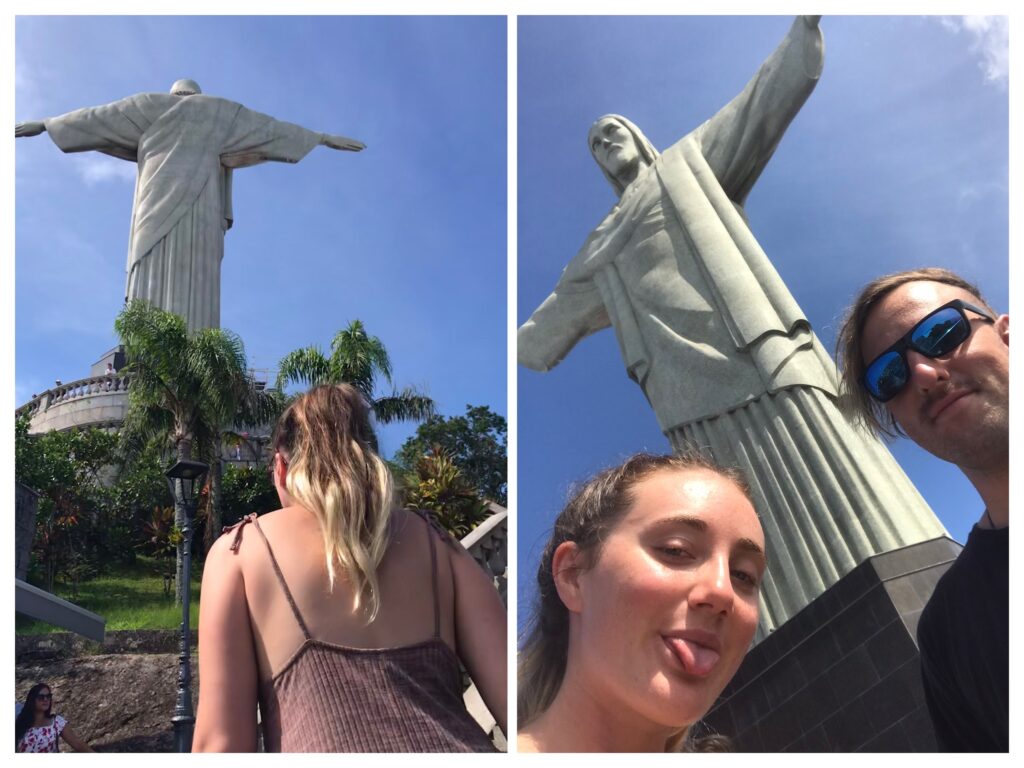
JC himself
Copacabana and Ipanema beach – my favourite memory from Rio is watching Dan charge into the sea, only to be barrelled over by a wave, lose his sunglasses in the sea and have his swimming trunks fall down exposing himself to the beach-goers. The waves are very strong here, expect to be knocked over if you go in the sea. I still can’t get Frank Sinatra out of my head, I spent the whole of my time in Brazil with Girl from Ipanema in my head. We found that Ipanema beach was a little less busy than Copacabana, and there were slightly less hawkers at Ipanema.
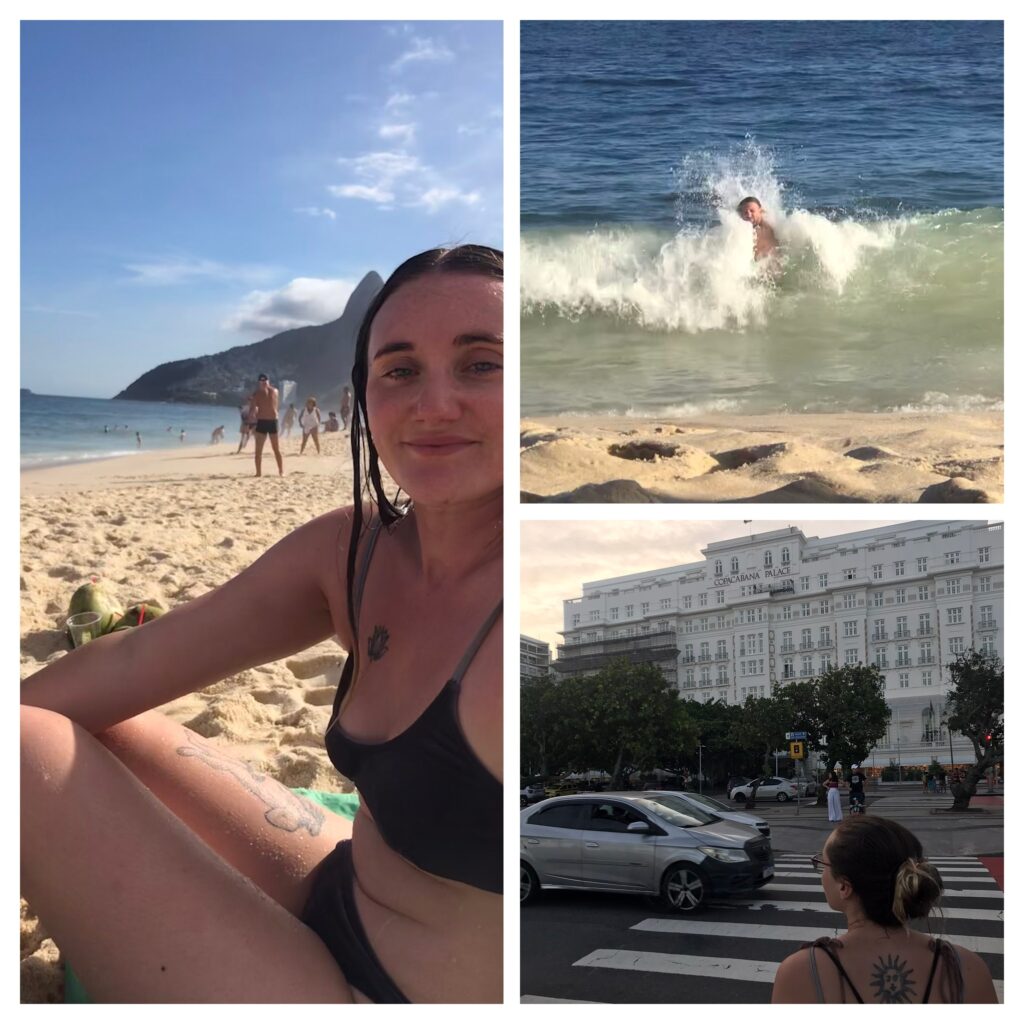
Free Walking tour of Rocinha Favela with Guruwalk – must-do tour, meeting a resident of the favela and hearing about how the favela is run by the cartel was very interesting with some great viewpoints of the favela along the way and an interactive capoeira session with a local community group, the guide even took us to his house that he shares with his family, it was a truly special and authentic experience navigating the warren of the favela. We were able to get to and from the favela easily by Uber.
Free Tour Pedra do Sal: Samba and Resistance with Guruwalk – very insightful and illuminating tour about the black experience in Brazil, I highly recommend this tour.
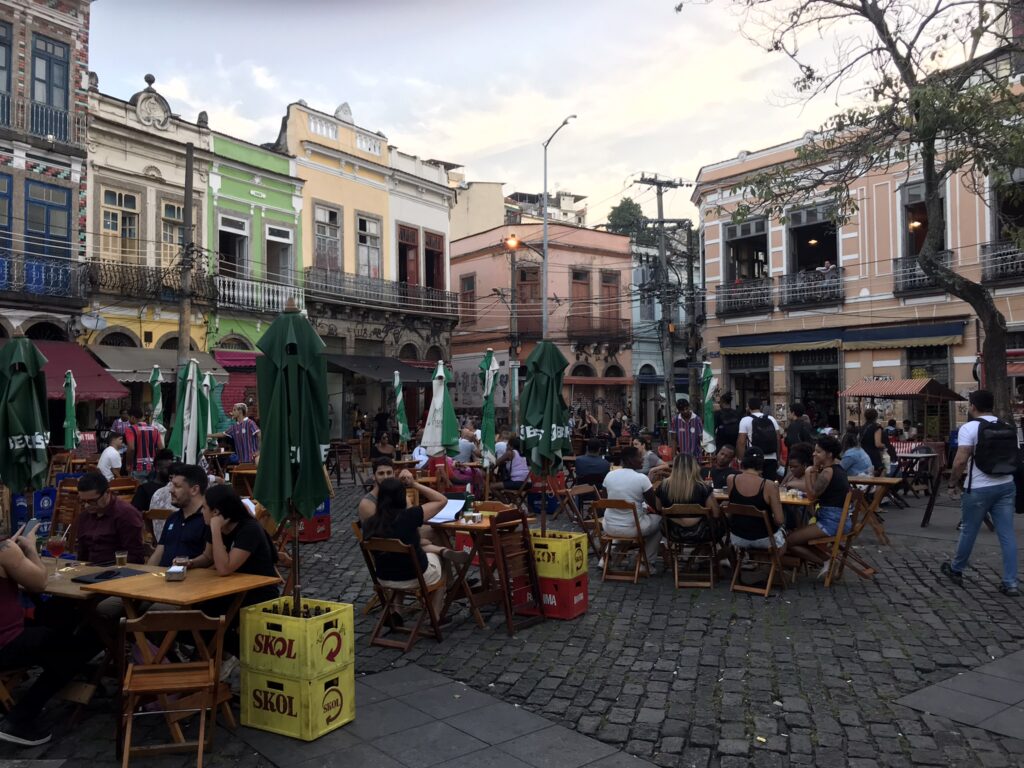
Pedra do Sal: Samba central
Free walking tour of the city centre – always a great place to start.
We opted not to go up Sugar loaf mountain as we were short on money and time by this point at the very end of our 7-month trip and had already admired the view from Christ the Redeemer, plus the ticket price was hefty to say the least.
Natal
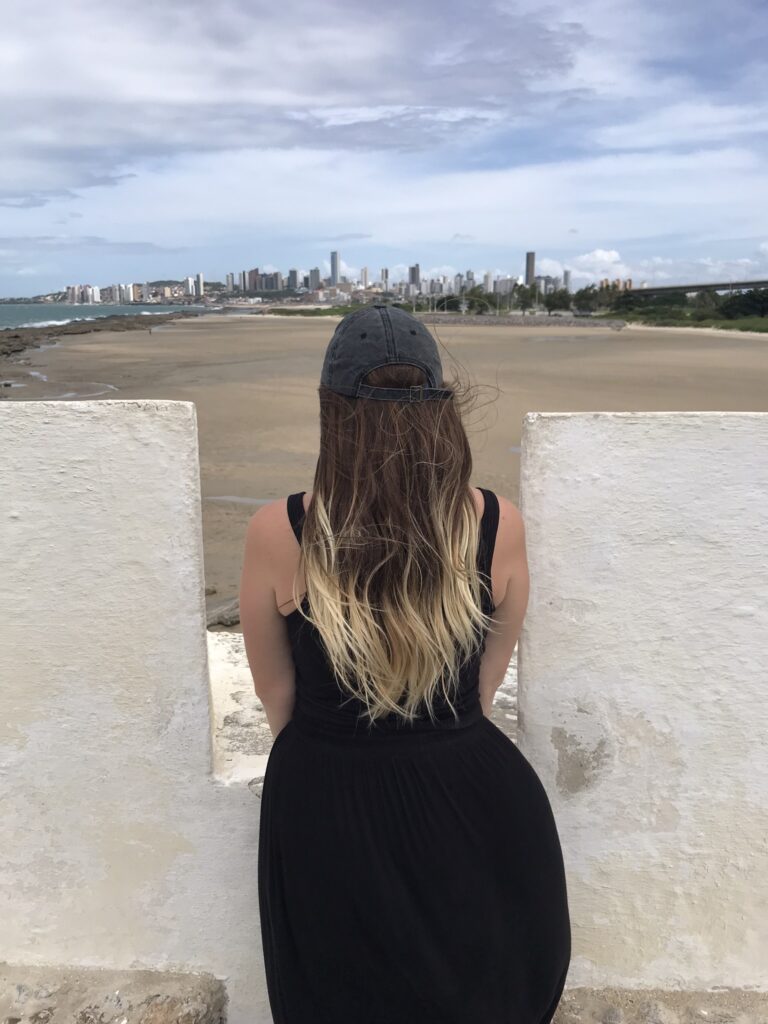
We spent, wait for it…a grand total of 12 hours in Natal between our flight from Rio and our outbound flight to Lisbon. We were able to get an Uber from the airport to the town and cram a couple of activities in this short time. According to some websites, Natal is one of the top 20 most dangerous cities in the world. I was shocked to find this out as the Natal we encountered felt safe and not threatening at all.
Foodie Places
Old Five Beach Restaurante – this beach bar serves cold beer and deep-fried nibbly bits.
Activities
Fortaleza dos Reis Magos – we got in for free here although I’m not sure if we just bypassed the ticket office. The fort is well worth a visit, the inside courtyard and original stone façade are very picturesque. The view from the top of the walls and the lookout points are definitely worth a peek! We got a bit stuck as we had to walk along the Praia do Forte (beach) to find somewhere with wifi so we could book an Uber to our next destination which was at the south of town near Morro de Careca. We enjoyed a coconut drink from a local cafe that had wifi and were able to get an Uber from there, which passed by some interesting sand dunes on the way to the southern part of town.
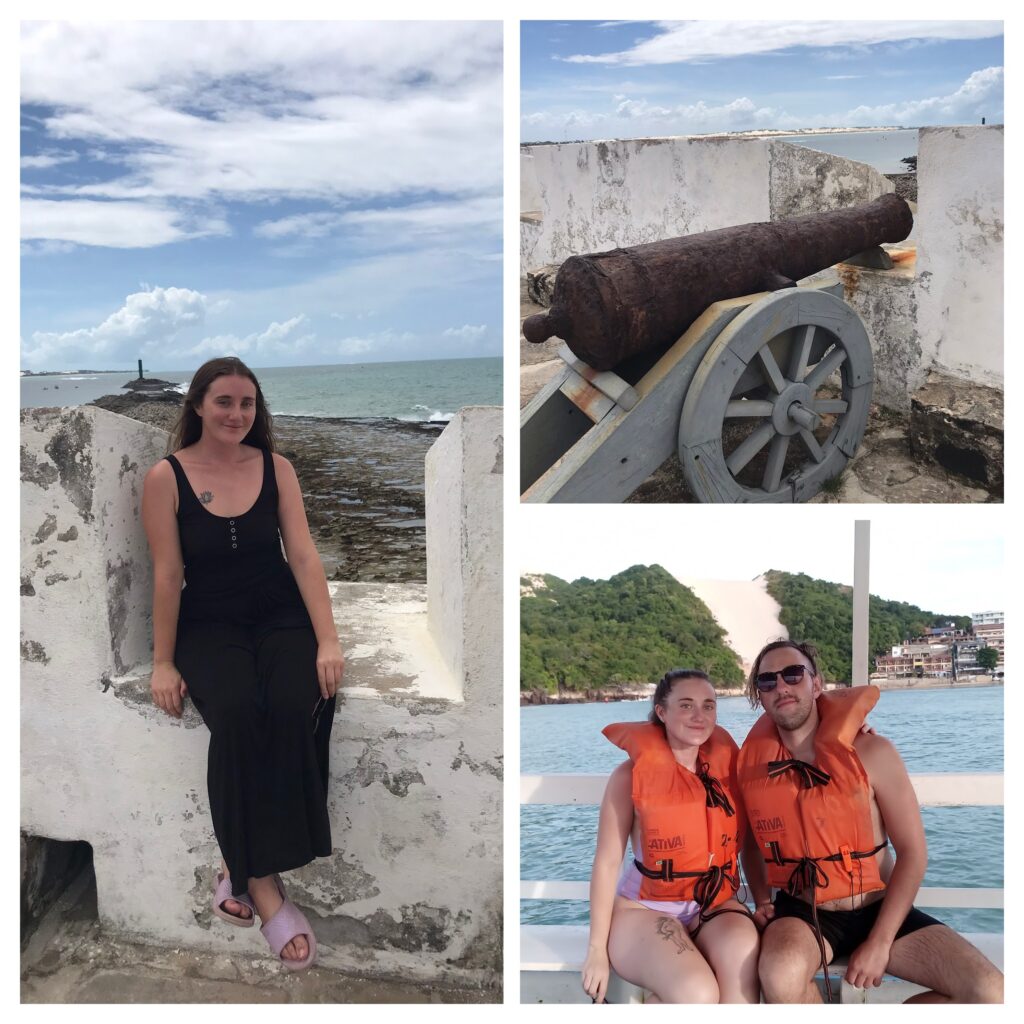
Boat trip with Jangalancha Show – we relaxed at Praia de Ponta Negra whilst waiting for our boat trip with the Jangalancha Show, the sea here was lovely and warm. We found Jangalancha to be a very professional company, they even had lockers to store your belongings and a non-pushy photographer. Jangalancha is the only company that is licensed to do this trip around the Morro as the area is controlled by the Brazilian military. We enjoyed the boat trip around the bay, especially spotting rare dolphins frolicking in the water. It was a great end to the South American leg of our journey.
